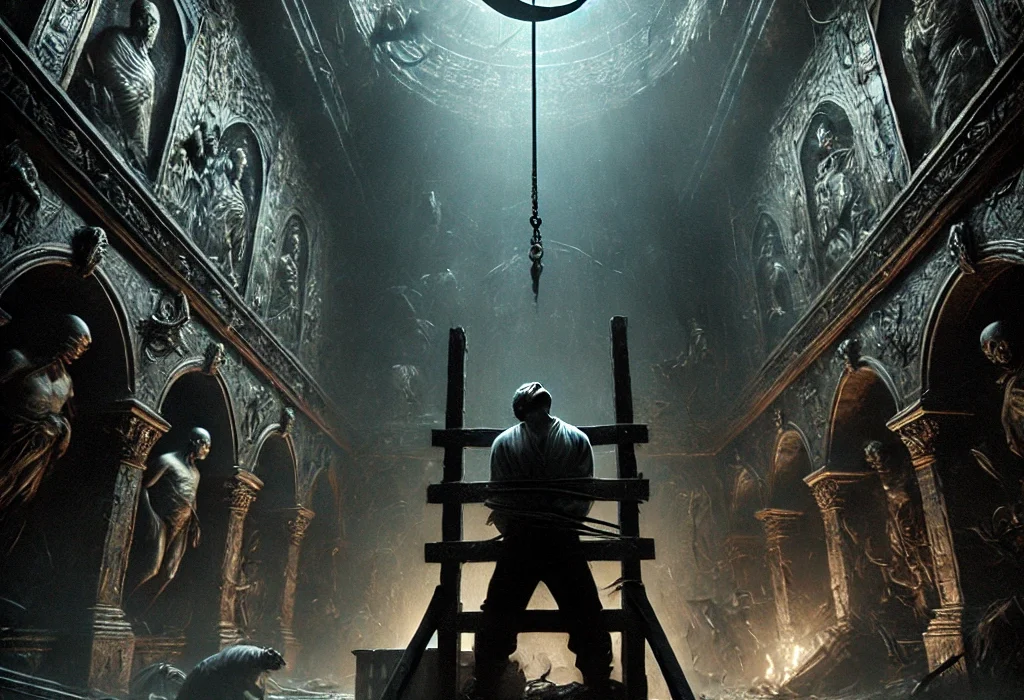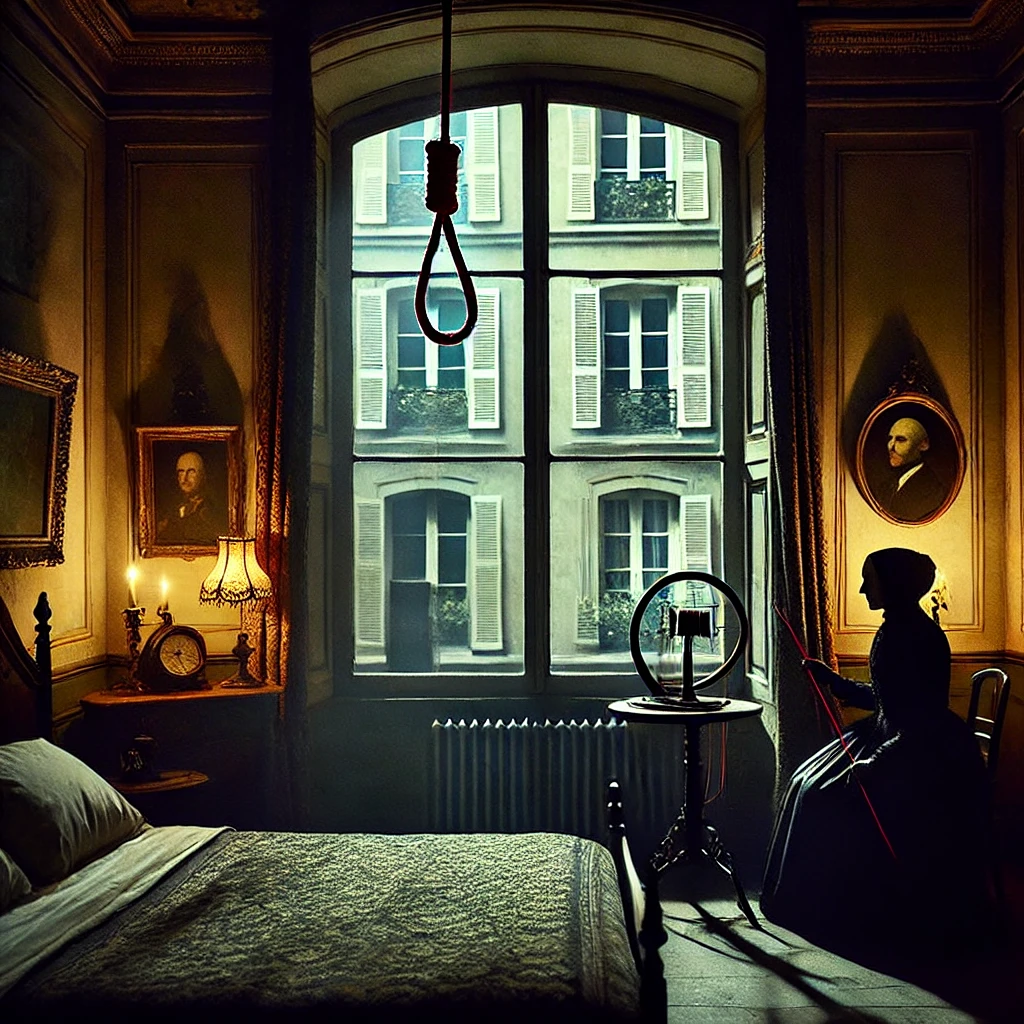In Edgar Allan Poe’s chilling short story, The Pit and the Pendulum, published in 1842, a man sentenced to death by the Spanish Inquisition grapples with fear, suspense, and despair as he faces terrifying torture devices in a pitch-black dungeon. Known for his mastery of horror and suspense, Poe leads readers into the narrator’s nightmarish world where he is condemned to a pitiless fate and must confront both physical and psychological horrors.
Plot Summary
Condemned by the Spanish Inquisition, a man is cast into a dark and silent chamber, his vision blurred by the residue of agony as he stirs from the surreal echoes of judgment. The last he recalls is the grim authority of robed figures, their faces pale with resolute cruelty as they pronounce his death sentence. He now finds himself lying unbound, though alone in an abyss of suffocating blackness. The silence around him stretches thickly, pulsing with his own dread, as if every sound has been swallowed by the walls.
Attempting to make sense of his predicament, he reaches out cautiously, hoping to discern the nature of his prison. Yet there is nothing but the damp, slippery floor beneath him, its sinister stillness reinforcing his belief that he has been abandoned in a tomb of eternal night. He hesitates, unnerved by the emptiness but eventually stands, stretching his hands out into the void and inching forward. After taking several cautious steps, his outstretched fingers strike the cold, smooth stone of a wall. He decides to follow its path, marking his point of origin with a torn strip from his robe. He counts his steps, his mind straining to remain rational in the face of mounting fear, but he soon realizes he can neither guess the shape of his cell nor its boundaries with certainty.
Seeking to cross the chamber’s center, his cautious steps falter as his foot slips upon something slick. He falls forward, yet feels nothing where his hand should meet solid ground; instead, a heavy vapor rises beneath his fingertips, and a dank, earthen scent fills his nostrils. He has stumbled upon the edge of a pit—a sheer drop into unknown depths, prepared as a trap to swallow the unwary prisoner. The discovery jolts his mind into terror. The Inquisition’s cruelty is evident in this silent maw that looms beneath him, and he shudders, recognizing he has barely escaped its grip.
The pit, however, is only the beginning of his torment. Exhausted, he loses consciousness and awakens to find a coarse meal of bread and water beside him, yet the sustenance brings him little comfort. With renewed dread, he notices a faint light growing within his chamber. The illumination, a ghostly glow from the walls, reveals ghastly figures painted in faded hues: skeletal faces and fiendish eyes leer from the shadows, creating an atmosphere that feels both infernal and otherworldly. As his sight adjusts, he discerns that the light emanates from a narrow gap along the floor’s edge, an unsettling revelation that the entire chamber is encased by metal plates, the iron walls stained and distorted by the oppressive damp.
In the oppressive quiet, his eyes drift to the ceiling where an immense figure is depicted: the personification of Time, bearing not the familiar scythe, but rather a heavy pendulum. Suspended directly above him, it seems an odd curiosity until he realizes the pendulum is moving, slowly, with a soft, insistent swish that grows louder with each swing. The blade—a massive crescent of sharp steel—begins its deadly descent, slicing the air with each pendulous swing, approaching ever closer to the man’s chest. Bound now to a wooden slab, he watches in paralyzed horror as it inches nearer, the deadly arc reducing with a chilling patience. He counts the oscillations, the rhythm drumming with his heartbeat, the blade a silent harbinger of his own end.
The pendulum swings closer, casting a cold draft upon his face. Desperate, he devises a last effort to survive, seizing upon the scraps of food left to him. Rubbing the oily remnants of his meal into the straps binding him, he draws the rats that scuttle in the chamber toward him. The vermin swarm over him, attracted to the scent, and as they gnaw at the straps in search of food, the bonds holding him weaken. In a frantic, shuddering moment, he wriggles free from the table, just as the pendulum completes another lethal arc. The device continues its swing, but he is spared its touch, scrambling from its deadly path.
Yet freedom from one peril does not ensure safety, for the Inquisition’s malice knows no limit. As the man escapes the table, he senses another change in the chamber. The walls begin to move, the metal plates groaning as they heat and shift, glowing with a lurid light that seeps into every corner of the room. The hideous murals contort, casting distorted shadows upon the floor. The chamber begins to narrow, each side pressing inward, urging him toward the pit he had barely avoided before. The glowing iron threatens to consume him, a fiery embrace that would surely end his suffering in an excruciating blaze.
His mind races as the walls press closer, the heat intensifying with each breath he draws. Sweat drips from his brow, and he steps backward, desperate to avoid the glowing walls. The pit yawns behind him, the gaping void his only refuge from the encroaching metal. Though every instinct urges him to recoil, he finds himself driven closer to the edge by the relentless pressure. With his final steps running out, he braces himself, teetering on the brink of surrender as he feels the ground shrink beneath him.
At that moment, a cacophony rises from beyond the walls—a clash of voices, the blast of trumpets. He is stunned, unable to comprehend the sudden intrusion of noise into his silent torment. In a miraculous turn, the chamber walls recoil, the machinery stills, and the iron menace that had nearly forced him into the pit retracts. He collapses, weakened but alive, barely comprehending the scene that unfolds before him.
An arm reaches down to pull him to safety. The French army, led by General Lasalle, has stormed Toledo, bringing an end to the Inquisition’s reign of terror. The dungeon, which had nearly become his grave, is now a sanctuary of light and sound. Rescued at the edge of despair, the man is lifted from his confinement, his escape as improbable as it is absolute. In a final moment of reprieve, he is borne out from the darkness into freedom, his ordeal in the pit left behind.
Main Characters
- The Narrator: Our main character remains nameless, embodying an everyman plunged into terror and despair. He is an intelligent and perceptive man, though helpless against the relentless cruelty of the Inquisition. Despite his fear, he shows resilience, facing each new horror with an instinctual drive for survival.
- The Inquisition Judges: Seen initially as shadowy figures, they represent the faceless, merciless power of the Inquisition. Though they never speak directly to the narrator, their unseen hand manipulates his fate through sadistic ingenuity.
Theme
- Terror of the Unknown: The narrator’s ordeal is compounded by his inability to see his surroundings, heightening his dread. This theme underscores the psychological aspect of horror, with the darkness acting as a metaphor for fear and ignorance.
- The Struggle for Survival: Throughout his torture, the narrator’s fight to stay alive becomes a central theme. His attempts to resist, even with fleeting hope, reflect the human spirit’s endurance.
- Time and Mortality: Time is ever-present, symbolized by the pendulum—a ticking clock counting down to the narrator’s end. This reminds readers of the inevitability of death and how humanity remains, at best, powerless against its approach.
- Hopelessness and Despair: The narrator faces one horror after another, each seeming insurmountable, leading him to question his will to survive. This emotional struggle exemplifies Poe’s exploration of the darker facets of the mind under duress.
Writing Style and Tone
Poe’s writing in The Pit and the Pendulum is immersive, combining rich, atmospheric descriptions with an intense focus on the narrator’s inner experience. His language is deliberate and vivid, evoking a palpable sense of dread. His use of first-person narration draws readers directly into the protagonist’s mind, making each fear and revelation more immediate and visceral. Poe’s pacing is masterful, with a gradual buildup of suspense that mirrors the narrator’s growing awareness of the terrors that surround him.
The tone is overwhelmingly dark and oppressive, yet imbued with an almost lyrical quality. Poe’s prose, laden with symbolic imagery, invites readers to experience not only the physical but also the psychological dimensions of horror. His language becomes a tool to explore the narrator’s despair, delving into the recesses of human fear, making The Pit and the Pendulum an unforgettable journey into the macabre.
We hope this summary has sparked your interest and would appreciate you following Celsius 233 on social media:
There’s a treasure trove of other fascinating book summaries waiting for you. Check out our collection of stories that inspire, thrill, and provoke thought, just like this one by checking out the Book Shelf or the Library
Remember, while our summaries capture the essence, they can never replace the full experience of reading the book. If this summary intrigued you, consider diving into the complete story – buy the book and immerse yourself in the author’s original work.
If you want to request a book summary, click here.
When Saurabh is not working/watching football/reading books/traveling, you can reach him via Twitter/X, LinkedIn, or Threads
Restart reading!








